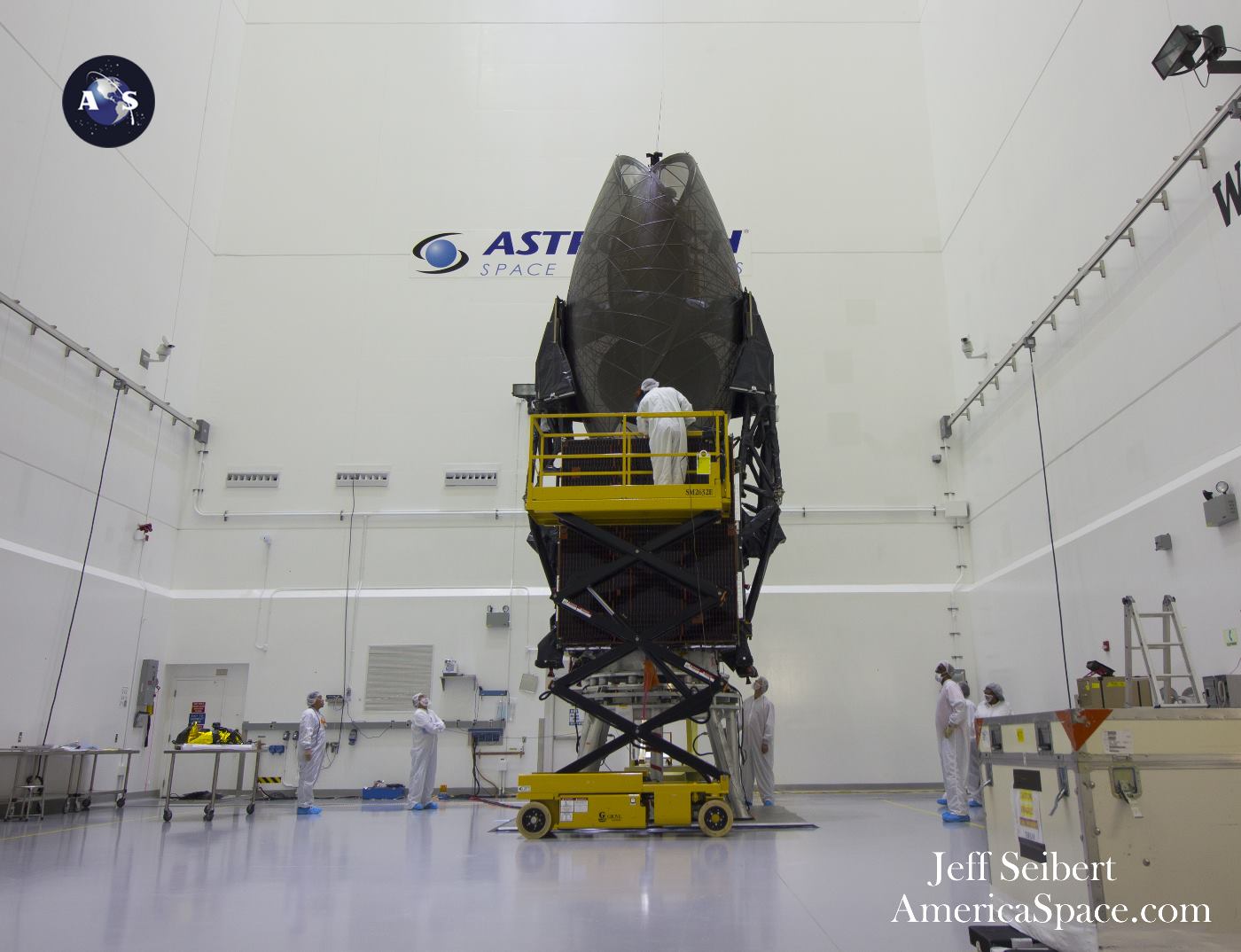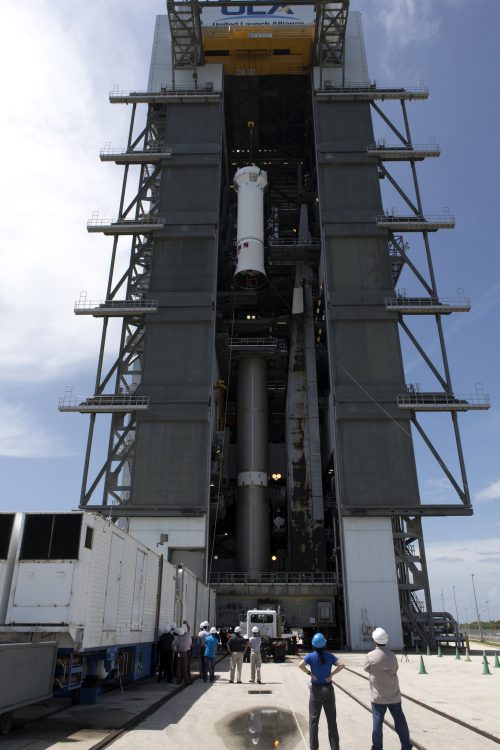
More than 30 years since its maiden launch—and having enabled near-continuous communications traffic between dozens of Space Shuttle and International Space Station (ISS) crews—NASA’s Tracking and Data Relay Satellite System (TDRSS) will welcome its 12th member into Geostationary Transfer Orbit (GTO) on Friday, 18 August. TDRS-M is currently targeted to launch from Space Launch Complex (SLC)-41 at Cape Canaveral Air Force Station, Fla., during a 40-minute “window”, which opens at 8:03 a.m. EDT. Providing the requisite muscle to get the 7,600-pound (3,450 kg) satellite into orbit will be United Launch Alliance’s (ULA) venerable Atlas V booster.
Upon arrival in its correct orbital “slot”, TDRS-M will be numerically redesignated “TDRS-13”, continuing a heritage which extends back to the early days of the Space Shuttle Program. Its first launch (TDRS-A) came aboard shuttle Challenger’s maiden voyage in April 1983 and what would have been the second satellite in the fleet—TDRS-B—was lost in the 51L tragedy in January 1986. During the post-Challenger era, TDRS featured heavily, with satellites launching on five shuttle missions between 1988 and 1995. These “first-generation” birds were followed by three “second-generation” TDRSes (designated H, I and J) in the 2000-2002 timeframe.

More recently, a third generation has taken shape, based upon Boeing’s flight-proven 601 spacecraft bus. Contracts to build TDRS-K and TDRS-L were awarded to Boeing in December 2007 and the satellites were launched atop ULA Atlas V boosters in January 2013 and January 2014, respectively. However, the language of the $695 million basic contract also provided for the construction of a third satellite, TDRS-M, and this option was exercised by NASA in November 2011. Identical to TDRS-K and TDRS-L, the new satellite was completed at Boeing’s El Segundo, Calif., facility in April 2016, whereupon NASA formally gave its consent to store it until a launch opportunity became available.
Having previously awarded launch contracts for TDRS-K and TDRS-L to ULA, it was unsurprising that NASA opted in October 2015 for the services of the Centennial, Colo.-headquartered organization to deliver the new satellite to orbit. As with its predecessors, TDRS-M would ride atop the “barebones” Atlas V 401, which boasts a 13-foot-diameter (4-meter) payload fairing, no strap-on rockets and a single-engine Centaur upper stage. When fully assembled, the pencil-like 401 stands 194 feet (59 meters) tall and is one of the world’s most reliable launch vehicles, with a 100-percent mission success rate.
The satellite itself was flown via U.S. Air Force C-17 transport aircraft to Space Coast Regional Airport in Titusville, Fla., on 23 June 2017, where it was ensconsed in Astrotech Space Operations’ payload processing facility, near Titusville, for pre-launch tests and fueling. A few days later, the other pieces for the TDRS-M launch campaign also began to converge on the Space Coast. The 106.5-foot-long (32.5-meter) Common Core Booster (CCB)—which forms the first stage of the Atlas V—was hoised upright inside the Vertical Integration Facility (VIF) at SLC-41 on 13 July. Next day, as tweeted by ULA CEO Tory Bruno, the 41.5-foot-long (12.5-meter) Centaur upper stage was installed.
The opening launch attempt was targeted for 3 August, but the hands of fate manifested themselves in the form of damage to TDRS-M’s Omni S-band antenna during final closeout activities on 14 July. In addition, engineers were closely monitoring a possible electrostatic discharge event with mechanical Ground Support Equipment (GSE). Over the following days, the damaged antenna was replaced and tested and the electrostatic discharge event resolved. Launch was initially rescheduled for no sooner than 20 August, but with Eastern Range approval was moved up to the 18th.
TDRS-M was transferred from the fueling stand and attached to its launch vehicle adapter, ahead of encapsulation within the two-piece (or “bisector”) Extended Payload Fairing (EPF) on 2 August. A week later, the complete payload was moved to the VIF at SLC-41 and raised into position atop the Atlas V, which was by this point in its complete configuration, with the CCB and Centaur upper stage integrated. On 9 August, the payload was in place atop the Atlas V, checking off another critical milestone before launch. “#TDRSM is at the pad for integration,” tweeted Mr. Bruno. “Looking forward to taking her to space soon.”
Early Thursday, the Atlas V will roll a quarter-mile (400 meters) from the VIF to the SLC-41 pad surface. ULA engineers will then set to work centering the stack and establishing propellant umbilicals and electrical and data connections. Shortly after rollout, 20,800 gallons (94,600 liters) of storable RP-1—a highly refined form of rocket-grade kerosene—will be loaded into the CCB tanks. This will be followed on Friday morning by the loading of liquid oxygen aboard the CCB, as well as liquid oxygen and hydrogen aboard the Centaur. All told, approximately 44,000 gallons (200,000 liters) of liquid oxygen and 10,580 gallons (48,100 liters) of liquid hydrogen will be tanked aboard the vehicle.

The weather outlook for both the primary (Friday) and backup (Saturday) launch attempts remains broadly similar to that which greeted SpaceX’s recent CRS-12 mission, with a predicted 70-percent likelihood of acceptable conditions at T-0. On both days, there exists a potential for seabreeze-induced showers and isolated thunderstorms. According to the 45th Weather Squadron at Patrick Air Force Base, favorable weather is anticipated for Thursday morning’s rollout to SLC-41, but Friday is expected to dawn with an elevated risk of mid-level and upper-level cloudiness, risking a violation of the Thick Cloud Rule and Cumulus Cloud Rule.
Assuming Friday’s launch preparations run smoothly, the countdown will emerge from its final built-in hold at T-4 minutes and the Atlas V propellant tanks will be pressurized. The critical Flight Termination System (FTS)—which would destroy the rocket, in the event of a major accident, during ascent—will be placed onto Internal Power and armed.
Two-and-a-half seconds before the planned 8:03 a.m. EDT launch time, the Russian-built RD-180 engine will roar to life, spooling up to its full 860,000 pounds (390,000 kg) of propulsive yield by T-0. Climb-out of the Atlas V 401 from the pad will commence at T+1.1 seconds. Shortly after clearing the SLC-41 tower, the vehicle will execute a combined pitch, roll and yaw program maneuver to position it onto the proper flight azimuth to inject the TDRS-M payload into orbit.
A minute into the flight, the Atlas V will exceed the speed of sound and pass through a period of maximum aerodynamic pressure (colloquially known as “Max Q”). Four minutes after leaving the Cape, the RD-180 will shut down and the CCB will be jettisoned. The turn will then come for the Centaur, whose Pratt & Whitney Rocketdyne-built RL-10C engine will ignite with a combined thrust of 22,900 pounds (10,390 kg). This restartable engine will support a 17.5-minute “burn” to deliver TDRS-M to geostationary altitude, followed by a minute-long second burn.
The satellite is expected to be deployed a little under two hours after launch, entering an initial orbit with an apogee of 22,237 miles (35,786 km) and a perigee of 2,883 miles (4,640 km), inclined 26.2 degrees to the equator. Over the next several months, TDRS-M will undergo checkout, before it is integrated into the existing TDRSS constellation. With an anticipated lifespan of at least 15 years, TDRS-M will expand NASA’s deep-space communications envelope beyond 2030.
Be sure to “LIKE” AmericaSpace on Facebook and follow us on Instagram & Twitter!





